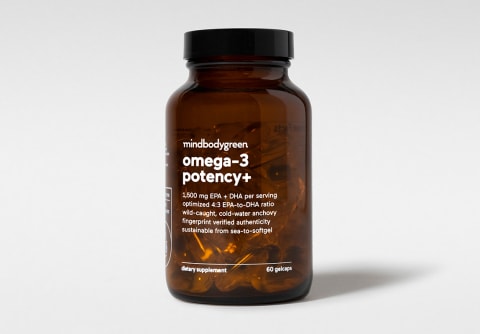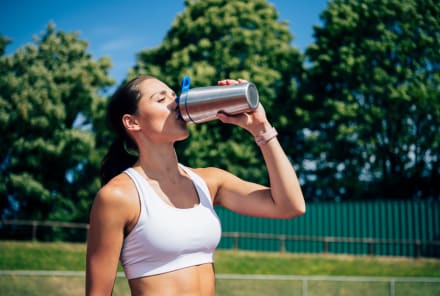Advertisement
New Clinical Guidelines Share Omega-3 Requirements For Women Of Reproductive Age


It's no secret that omega-3 fatty acids (ones typically found in fish like salmon and sardines) are critical for the heart, brain, and skin. But they're also vital during pregnancy (to support healthy brain development of the baby and reduce the likelihood of preterm births) and for women's reproductive health in general—regardless of whether you're trying to conceive.
But your diet—and even your prenatal vitamin—is likely falling short of what's optimal for these life stages. So we're breaking down the (pretty confusing) recommendations on exactly how much EPA and DHA omega-3 fats most women between the ages of 20 and 45 need.
Recommended omega-3 for women's health
The recommended minimum amount of omega-3s for reproductive-aged women is about 250 milligrams of combined EPA and DHA a day. (For reference, most adults in the U.S. only get 86 milligrams1 a day.)
But even higher intake of omega-3 foods and supplements is linked to a slew of benefits:
- Reductions in PMS symptoms: A 2022 systematic review and meta-analysis found that omega-3s were effective at reducing the severity of PMS symptoms in women. And researchers of a 2013 study found that supplementing with 2 grams a day of EPA and DHA significantly relieved signs of depression2, anxiety, nervousness, bloating, and concentration issues after 45 days.
- Fertility: Studies show that higher omega-3 intake3 and supplementation4 are linked to higher conception rates.
- A proactive approach to healthy aging: A lot of the research for omega-3s is centered around slightly older populations (people 50+). In general, these studies show that higher omega-3 intake or supplementation with 1,000 to 2,000 milligrams supports cognitive vitality, vision longevity, joint mobility, heart health, antioxidant activity, and social well-being. And it's never too early to get a head start on some of these benefits.
Recommended omega-3 intake during pregnancy
Now, omega-3 recommendations to increase a bit during pregnancy. According to new clinical practice guidelines for the American Journal of Obstetrics & Gynecology Maternal-Fetal Medicine state that in addition to the 250 milligrams per day of combined EPA & DHA daily, pregnant women need an additional 100-200 milligrams of DHA specifically.
Women who are at risk for preterm labor or who have low DHA intake (less than 150 milligrams daily) need a daily supply of 1,000 milligrams of EPA and DHA or just DHA.
As most U.S. adults are only consuming about 86 milligrams1, most women fall into this later category.
Omega-3s support a healthy pregnancy by:
- Lowering the risk of preterm births
- Supporting healthy fetal brain5 development
- Helping reduce some symptoms of postpartum depression
How to get more omega-3s
You can always up your omega-3 intake through your diet—and eating a few more servings of fatty fish a week is the most efficient way to do that. Just 3 ounces of salmon6 provides almost 2,000 milligrams of EPA and DHA, and 3 ounces of anchovies7 gets you around 1,500 milligrams.
If you opt for a supplement, look for ones that provide about that much (1,000 to 2,000 milligrams per serving). Although this number is much higher than general recommendations, those recommendations are really a minimum threshold. Data on both safety and efficacy show that supplementing into the thousands of milligrams is beneficial.
It's still smart to supplement with omega-3s even if you're taking a prenatal. Many prenatal vitamins on the market now have combined between 200 and 250 milligrams of DHA into the formula, which is great. But it doesn't cover all your EPA & DHA needs, and you're still likely missing out on these key fats.
There are a lot of fish oil supplements out there, and many are low-quality ones8 that have already turned rancid. So, we did the research for you and narrowed down our top omega-3 supplement picks here (and they've all been expert-vetted).
The takeaway
Getting enough omega-3s at every life stage is important for overall health, and these nutrients play unique and specific roles for women during the reproductive years. Leaning on a high-quality omega-3 supplement is an easy and convenient way to make sure you're getting what you need every day—even if you eat a lot of salmon.
8 Sources
- https://www.ncbi.nlm.nih.gov/pmc/articles/PMC3992162/
- https://pubmed.ncbi.nlm.nih.gov/23642943/
- https://pubmed.ncbi.nlm.nih.gov/35364062/
- https://pubmed.ncbi.nlm.nih.gov/35147198/
- https://www.ncbi.nlm.nih.gov/pmc/articles/PMC7759779/
- https://fdc.nal.usda.gov/fdc-app.html#/food-details/175167/nutrients
- https://fdc.nal.usda.gov/fdc-app.html#/food-details/174182/nutrients
- https://pubmed.ncbi.nlm.nih.gov/37712532/
Watch Next
Enjoy some of our favorite clips from classes
Enjoy some of our favorite clips from classes
What Is Meditation?
Mindfulness/Spirituality | Light Watkins
Box Breathing
Mindfulness/Spirituality | Gwen Dittmar
What Breathwork Can Address
Mindfulness/Spirituality | Gwen Dittmar
The 8 Limbs of Yoga - What is Asana?
Yoga | Caley Alyssa
Two Standing Postures to Open Up Tight Hips
Yoga | Caley Alyssa
How Plants Can Optimize Athletic Performance
Nutrition | Rich Roll
What to Eat Before a Workout
Nutrition | Rich Roll
How Ayurveda Helps Us Navigate Modern Life
Nutrition | Sahara Rose
Messages About Love & Relationships
Love & Relationships | Esther Perel
Love Languages
Love & Relationships | Esther Perel


















